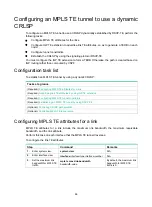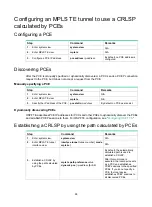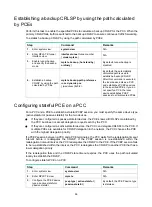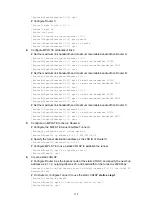
98
Step Command
Remarks
2.
Configure a static route to
direct traffic to an MPLS TE
tunnel.
See
Layer 3—IP Routing
Command Reference
.
By default, no static routes exist.
The interface specified in this
command must be an MPLS TE
tunnel interface.
Configuring PBR to direct traffic to an MPLS TE tunnel
For more information about the commands in this task, see
Layer 3—IP Routing Command
Reference
.
To configure PBR to direct traffic to an MPLS TE tunnel:
Step Command
Remarks
1.
Enter system view.
system-view
N/A
2.
Create a PBR policy node
and enter policy node view.
policy-based-route
policy-name
[
deny
|
permit
]
node
node-number
By default, no PBR policies
node exist.
3.
Configure an ACL match
criterion.
if-match acl
{
acl-number
|
name
acl-name
}
By default, no ACL match
criterion is configured.
4.
Specify a tunnel interface
as the packet output
interface.
apply output-interface
{
tunnel
tunnel-number
[
track
track-entry-number
] }&<1-2>
N/A
5.
Return to system view.
quit
N/A
6.
Apply the PBR policy.
•
To apply the policy to the local
device:
ip local policy-based-route
policy-name
•
To apply the policy to an interface:
a. interface
interface-type
interface-number
b. ip policy-based-route
policy-name
By default, no policy is
applied.
Configuring automatic route advertisement to direct traffic to
an MPLS TE tunnel
You can use either IGP shortcut or forwarding adjacency to implement automatic route
advertisement. When you use IGP shortcut, you can specify a metric for the TE tunnel. If you assign
an absolute metric, the metric is directly used as the MPLS TE tunnel's metric. If you assign a relative
metric, the MPLS TE tunnel's metric is the assigned metric plus the IGP link metric.
Before configuring automatic route advertisement, perform the following tasks:
•
Enable OSPF or IS-IS on the tunnel interface to advertise the tunnel interface address to OSPF
or IS-IS.
•
Enable MPLS TE for an OSPF area or an IS-IS process by executing the
mpls te enable
command in OSPF area view or IS-IS view.
Follow these restrictions and guidelines when you configure automatic route advertisement:
•
The destination address of the MPLS TE tunnel can be the LSR ID of the egress node or the
primary IP address of an interface on the egress node. As a best practice, configure the
destination address of the MPLS TE tunnel as the LSR ID of the egress node.






























